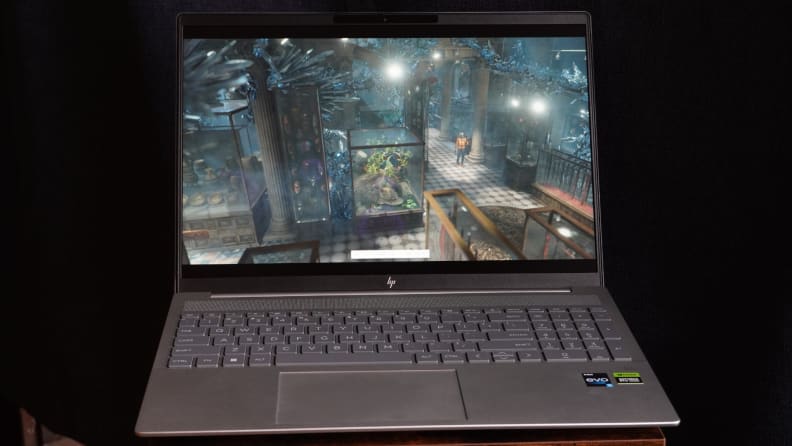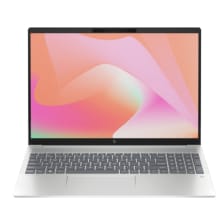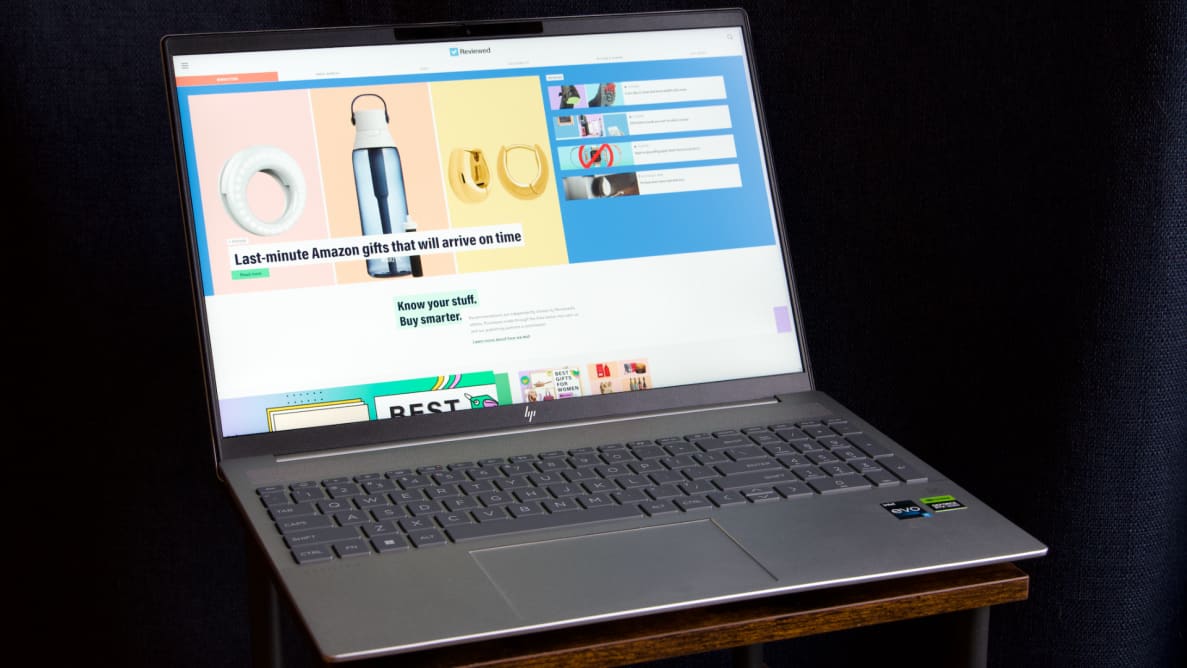Pros
-
Great performance and battery life
-
Bright and clear display
-
Slim design
Cons
-
So-so keyboard
-
No simple GPU toggle
About the HP Pavilion Plus 16
The 2023 HP Pavilion Plus 16 comes in a handful of fairly similar configurations, with HP making it fairly easy to find one that suits you through its online configurator.
Prices for the Pavilion Plus 16 start at $1,100 for a base model that includes an Intel Core i5-13500H, Iris Xe integrated graphics, 16GB of memory, and 512GB of storage. The CPU can be bumped up to an Intel Core i7-13700H for an extra $50 and the graphics can jump up to an RTX 3050 for $100, and HP provides the option to choose whether you want one or both upgrades.
Storage is expandable to 1TB for an extra $110, and the Windows 11 version can be upgraded to Pro for $70. HP also provides a gold chassis option for $19 extra. Taking every upgrade HP offers, the price rises to $1,449, which isn’t a huge leap. All configurations come with the same 16-inch, 16:10 2560 x 1600 IPS display. It’s worth noting HP regularly has sales that can lop a huge chunk off the price. The configuration tested here has a $1,200 list price but was available for $730 at the time of testing.
HP Pavilion Plus 16 specs
- Price as configured: $1,200
- Processor: Intel Core i5-13500H, 12-core/16-thread, max speed 4.7GHz
- Graphics: Intel Iris Xe (integrated), Nvidia GeForce RTX 3050 6GB (discrete)
- Memory: 16GB LPDDR5x 5200MHz
- Storage: 512GB M.2 PCIe 4.0 with TLC
- Display: 16-inch, 2560 x 1600, 400 nits max (rated); 458.1 nits max (measured), variable refresh rate enabled (48-120Hz), IPS anti-glare
- Ports: 1 x Thunderbolt 4, 1 x USB C 3.2 Gen 2 (DP1.4, PD), 1 x USB A 3.2 Gen 2, 1 x USB A 3.2 Gen 1, 1 x HDMI 2.1, 1 x 3.5mm audio combo jack, 1 x DC power in
- Connectivity: Wi-Fi 6E, Bluetooth 5.3
- Battery: 4-cell, 68Wh Lithium-Ion Polymer
- Weight: 4.09 pounds (1.85 kilograms)
- Dimensions: 14.06 x 9.98 x 0.7 inches
- Special features: 5MP webcam with IR and facial recognition, webcam privacy shutter, microphone mute key, white keyboard backlighting
- Warranty: 1-year limited hardware warranty support
What we like
Performance is surprisingly good

The Pavilion Plus 16 isn't a gaming laptop, but expect good performance and display regardless.
The HP Pavilion Plus 16 isn’t a top-of-the-line, expensive powerhouse of a machine, but it’s impressively speedy. The processor in our review unit is more than up to the task of everyday computing and then some, keeping up admirably with some of the most powerful productivity laptops we’ve tested. It’s a delight to know that so much performance is available at such reasonable prices.
HP offers the option to add discrete graphics, further boosting the value of the machine. If you know you don’t need it, you can save some money, but for anyone with a graphical workload like rendering 3D images from time to time or editing video, the boost available from even the low-end RTX 3050 is considerable.
Our 3D rendering test using Blender’s Barbershop demo took over half an hour on the CPU, for instance, but the GPU was able to cut that down to under seven minutes. It also has enough juice to tap into games that the integrated graphics would struggle with.
The display has a lot of great qualities
Between its resolution and refresh rate, the HP Pavilion Plus 16’s display starts off strong. 2,560 x 1,600 pixels stretched across 16 inches provides plenty of clarity and a decent workspace for side-by-side windows. I can easily view a full page of a document with legible text and still have room to spare.
The 120Hz max refresh rate offers a smoother experience which is enjoyable in everyday use and gaming. The display has a variable refresh rate that can shift as low as 48Hz to match the frames per second being output while gaming, which helps to eliminate stuttering or choppiness.
HP tops all of that off with high brightness levels and an anti-glare finish, which makes it exceedingly easy to see what's on screen in most conditions. Even running the display at only 200 nits provides a clear picture with little interference from glare in a well-lit room. But the display can reach as high as 458 nits to cancel out any ambient light.
The screen is fairly colorful as well, covering 99% of the sRGB color space, making it decent for content consumption. Color coverage is one area many laptop displays slack, and while the Pavilion Plus 16 could certainly go further, it’s not bad at all for a system that goes on sale for under $700.
The design is sleek

It's an easy laptop to transport and has a subdued design.
The HP Pavilion Plus 16 isn’t the smallest or slimmest machine, but it’s fairly compact for a laptop packing a 16-inch display and discrete graphics. Quite impressively, it manages to slip right into a pocket in my backpack that’s better suited to 14-inch laptops.
It’s a little bit of a squeeze, but the Pavilion Plus 16 is fairly happy to slide in and out thanks to its smooth, metal exterior. HP has given the Pavilion brand a glow-up in the style department in recent years, and the Pavilion 16 Plus shows it off.
Battery life is exceptionally good
The HP Pavilion Plus 16 packs a large, bright display alongside a high-performance CPU and discrete GPU. This usually is not the recipe for a long battery life, but the system pulls it off. When it’s not hit with a demanding task, the CPU doesn’t pull too much power and the GPU goes idle—crucial for sipping power. The already efficient display can also run at 60Hz instead of the full 120Hz when it wants to conserve power.
Even though the Pavilion Plus 16 only has a 68Wh battery (some competitors go up to 99Wh, the limit for laptops to be allowed on airplanes in the U.S.), it manages to offer some of the longest battery life we’ve seen from a Windows laptop. With a runtime of 13 hours and 10 minutes in our battery test, which cycles between active browser tabs constantly with the laptop display set to a 200-nit brightness level, the Pavilion Plus 16 comes out on top of even some Apple products. It bests the MacBook M2 15 at 13 hours, and MacBook Pro 15 M2 Max at a few minutes under 13 hours.
What we don’t like
Adaptive contrast can interfere with display quality
For all its admirable qualities, the display on the HP Pavilion Plus 16 has one annoying hiccup that’s noticeable from time to time. It uses an adaptive contrast feature—something I’ve seen on the occasional laptop—that shifts the brightness and contrast levels depending on what’s on the display. The issue is that it’s not very fast.
When switching from a dark tab to a bright one in my browser, the bright tab will sometimes appear extra dim, with fine details like text or spreadsheet cell outlines appearing faint because of the lower white levels until the display shifts its brightness and contrast to better resolve those details. Unfortunately, I’ve found no way to disable this feature.
The keyboard could use some refinement

There's a bit of space between each key.
The HP Pavilion Plus 16’s keyboard isn’t particularly bad, but it’s not great. The keys have a decent bit of travel to them but they aren’t very contoured, which can make it hard to hone in on the center of each keycap while typing. That issue compounds the other: the keys are a little squishy and wobbly.
HP doesn’t have the best key stabilization on many of its laptops, so pressing near the corners of keys can see them bend downward with a bit of a tilt instead of traveling down uniformly. This makes for less pleasant and more error-prone typing, as it’s a little too easy to roll off the edge of one of the keys and hit its neighbor. I’m still able to type along at a reasonable 100 to 110 words per minute, but trying for much beyond that feels a little rushed without the assurances of better, more consistent keycaps.
HP included keyboard backlighting and some indicator lights, but it left out a Num Lock indicator. For a laptop with a number pad, that’s a handy indicator to have. Without it, you’re left to press keys and discover for yourself whether it’s in the number or navigation mode.
Even with all the space available to the Pavilion Plus 16, HP didn’t bother to do anything better with the arrow keys. They’re still the same cramped cluster found on most laptops with the up and down arrows shrunken to half-size. The design is already a nuisance for navigation on other laptops, but it’s worse when the keys are wedged next to the number pad and have no tactile bumps to help find them without looking down.
Toggling between discrete and integrated graphics could be simpler
Discrete graphics are great to have for speeding through certain tasks, but they can also be a huge drain on the battery. Most gaming laptops ship with some sort of command center application to help you easily control when to run and when to disable the GPU to conserve power. The HP Pavilion Plus 16 doesn’t have that. The graphics settings in Windows provide some control, but you have to decide whether the GPU gets to run on a per-app basis.
The Pavilion Plus 16 may not be a gaming machine, but that common gaming laptop feature would be useful here. As impressive as the battery life is, that was thanks to the system sticking to integrated graphics instead of the discrete GPU. Unwittingly using the RTX 3050 to handle tasks could turn that 10+ hour battery life into under 2 hours.
Cooling isn’t very effective

The Pavilion Plus 16 thermal throttled in our testing, but it shouldn't happen in day-to-day use. Hot air is ejected out of vents positioned under the screen.
It’s worth pointing out that the Pavilion Plus 16 can see fairly hot CPU temperatures. While the laptop has good performance, it could have been even better if the system were better about keeping the CPU cool.
In testing under a full artificial load, the processor hit 100 degrees Celsius. At this point, the CPU has to dial back its speeds to avoid damage. This didn’t prevent it from performing quite well overall, and it shouldn’t have as much issue with shorter tasks that don’t heat up the CPU as much. The heat also doesn’t substantially spread to the chassis, so despite the serious hotspot for the CPU, the hottest I measured the frame of the laptop was at a modest 96.4 degrees Fahrenheit (35.7 degrees Celcius).
Should you buy the HP Pavilion Plus 16?
Yes, especially if you can snag it at a discount
The 2023 HP Pavilion Plus 16 varies from a modest value to an exceptional one when any of the common, steep discounts are applied. The specific configuration I tested is a quality laptop that’s sleek, modestly powerful, and well-rounded with a versatile display and long-lasting battery. It’s hard to get so many qualities right for a low price, and while $1,100 is fairly low, deals make it so much better (often under $800).
Of course, the Pavilion Plus 16 isn’t without its faults. But none of them are major. They may prevent the machine from being outright exceptional, but none stand out as a reason not to seriously consider the Pavilion Plus 16. It might take a little more care to make the most of, but that’s a small trade-off for the value here. It proves a viable alternative to the LG Gram 17 or Apple’s 15-inch MacBooks, and though it may be a little heavier, it is significantly cheaper.
The Pavilion Plus 16 is a well-rounded product, and that’s more or less the perfect place for a laptop to land since they have to wear many hats. Having performance plugged in, battery life on the go, a quality display, and a portable design make the Pavilion Plus 16 a great all-arounder.

The 2023 HP Pavilion Plus 16 is a stellar MacBook or Dell XPS competitor for the price.
Meet the tester

Mark Knapp
Contributor
Mark Knapp has covered tech for most of the past decade, keeping readers up to speed on the latest developments and going hands-on with everything from phones and computers to e-bikes and drones to separate the marketing from the reality. Catch him on Twitter at @Techn0Mark or on Reviewed, IGN, TechRadar, T3, PCMag, and Business Insider.
Checking our work.
Our team is here to help you buy the best stuff and love what you own. Our writers, editors, and experts obsess over the products we cover to make sure you're confident and satisfied. Have a different opinion about something we recommend? Email us and we'll compare notes.
Shoot us an email



